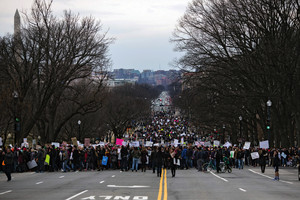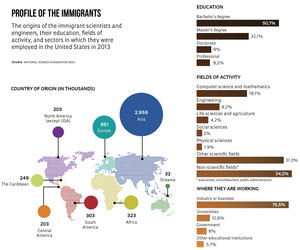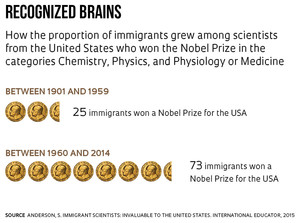
Freelancer/AFP/Getty Images
Demonstrators in Washington, DC protest the new administration’s immigration policy in JanuaryFreelancer/AFP/Getty ImagesThe desire by new U.S. President Donald Trump to reduce the number of immigrants in that country has frightened leaders of American universities, research institutions and technology companies. The president’s first action was draconian: a week after his inauguration, he ordered suspension of the refugee admission program and vetoed the entry of citizens from seven Muslim countries, even persons holding permanent resident documents. U.S. courts suspended the effects of the decree a few days later. On March 6, 2017, Trump introduced a less severe version of the decree, which honors rights already acquired.
The reaction from the science community was instantaneous. Harvard University President Drew Faust published a statement in which he pointed out that thousands of foreigners come to Harvard every year to study, conduct research, and share knowledge that in his words, “transcends nationality.” Leo Rafael Reif, a Venezuelan and president of the Massachusetts Institute of Technology, also reiterated the importance of immigrants, saying: “More than 40% of our faculty are international…in a nation made rich by immigrants, why would we signal to the world that we no longer welcome new talent?” Executives of technology companies like Google, Facebook, Apple, and Microsoft also condemned the new president’s immigration policy.
 Trump’s isolationist posture conflicts with a strategy that, historically, has helped build the most solid system of science, technology, and innovation on the planet. Attracting talent from abroad has become a means of financing the functioning of universities, supplying companies with skilled workers, and bringing together top-ranking researchers. The U.S. has been heavily dependent on this resource. The number of foreign students attending institutions of higher education in the United States in 2016 passed the one million mark for the first time, according to the Institute of International Education (IEE). That contingent, coming primarily from countries such as China, India, South Korea, Saudi Arabia, Brazil, and Mexico, represents 5% of the 20 million students admitted to universities and is an important source of financing for those institutions. Of total foreign students, 17,000 came from Syria, Iran, Libya, Somalia, Yemen, Iraq and the Sudan, countries targeted by the Trump decree.
Trump’s isolationist posture conflicts with a strategy that, historically, has helped build the most solid system of science, technology, and innovation on the planet. Attracting talent from abroad has become a means of financing the functioning of universities, supplying companies with skilled workers, and bringing together top-ranking researchers. The U.S. has been heavily dependent on this resource. The number of foreign students attending institutions of higher education in the United States in 2016 passed the one million mark for the first time, according to the Institute of International Education (IEE). That contingent, coming primarily from countries such as China, India, South Korea, Saudi Arabia, Brazil, and Mexico, represents 5% of the 20 million students admitted to universities and is an important source of financing for those institutions. Of total foreign students, 17,000 came from Syria, Iran, Libya, Somalia, Yemen, Iraq and the Sudan, countries targeted by the Trump decree.
Figures from the National Science Foundation show that the group of immigrant engineers and researchers in the U.S. has grown in recent years. In 2003, they accounted for 16% of all engineers and scientists; in 2013, they were 18%. Another study, this one from the National Foundation for American Policy, revealed that 51% of U.S. startup companies, with a combined worth of at least $1 billion, counted immigrants among their founders.
 “Highly qualitied immigrants are not stealing our jobs, because we don’t have enough professionals in the United States to fill those positions. Instead, they are creating new jobs by establishing industries that did not exist before,” said theoretical physicist Michio Kaku, of City University of New York in a videotaped lecture distributed over social networks. In the opinion of Reginaldo Moraes, a professor at the University of Campinas (Unicamp) and researcher at the National Institute of Science and Technology for Studies of the United States (INCT-INEU), Trump’s action, although not directed against scientists, may discourage students and researchers from going to the United States. “Many foreigners who were planning to study or do research there are probably feeling threatened now, and may well give up the idea,” Moraes says. “I think Trump wants to accentuate the xenophobia he observed among his electorate, which sees immigrants as competitors in the labor market. He is not aiming at academia, but at low-income immigrant workers.” On February 28, 2017, Trump addressed a joint session of Congress and, for the first time, walked back his position somewhat, saying: “Switching away from this current system of lower-skilled immigration, and instead adopting a merit-based system, we will have so many more benefits. It will save countless dollars, raise workers’ wages, and help struggling families — including immigrant families — enter the middle class.”
“Highly qualitied immigrants are not stealing our jobs, because we don’t have enough professionals in the United States to fill those positions. Instead, they are creating new jobs by establishing industries that did not exist before,” said theoretical physicist Michio Kaku, of City University of New York in a videotaped lecture distributed over social networks. In the opinion of Reginaldo Moraes, a professor at the University of Campinas (Unicamp) and researcher at the National Institute of Science and Technology for Studies of the United States (INCT-INEU), Trump’s action, although not directed against scientists, may discourage students and researchers from going to the United States. “Many foreigners who were planning to study or do research there are probably feeling threatened now, and may well give up the idea,” Moraes says. “I think Trump wants to accentuate the xenophobia he observed among his electorate, which sees immigrants as competitors in the labor market. He is not aiming at academia, but at low-income immigrant workers.” On February 28, 2017, Trump addressed a joint session of Congress and, for the first time, walked back his position somewhat, saying: “Switching away from this current system of lower-skilled immigration, and instead adopting a merit-based system, we will have so many more benefits. It will save countless dollars, raise workers’ wages, and help struggling families — including immigrant families — enter the middle class.”
Tullo Vigevani, a professor at the Marília campus of the São Paulo State University (Unesp) and also a member of the INCT-INEU, says that blocking the entry of foreign researchers will have serious consequences for the United States. “Universities and research institutions will not only lose critical mass but will also need to raise their fees, thus increasing the cost to the country of training new researchers,” he concludes. “One of the advantages of accepting these students and researchers is that you are adding people who are already prepared to make a contribution. Those immigrants are part of the so-called brain drain from their home countries.”
 Science diplomacy
Science diplomacy
One concern among the science community is to find out whether Trump will continue the tradition of using science diplomacy, i.e., using science as an arm of foreign policy. In January 2017, Rush Holt, president of the American Association for the Advancement of Science (AAAS), sent a letter to the U.S. Senate citing episodes in which that country used science diplomacy in the 1970s as a means of improving relations with China by promoting collaboration among researchers. On another front, American and Cuban scientists have formed partnerships to conduct research on cancer and hurricane prediction. With his letter, Holt was hoping to encourage senators to take advantage of the hearing to be held on the nomination of Rex Tillerson as new secretary of state to urge the administration to use science in foreign policy.
The concept of science diplomacy is comprehensive. It encompasses the formation of consortia between countries to conduct international science programs, using science cooperation to bring together countries whose relationships have been shaky, and the assistance that researchers can provide in diplomatic negotiations and international treaties. According to Robert Patman, a professor of international relations at the University of Otago, New Zealand and author of a book on science diplomacy, the Trump administration has already expressed disdain for one of the two strategies mentioned above—the involvement of researchers in diplomatic negotiations. It is not expected, for example, that the president is contemplating including scientific knowledge in conferences about climate change. “Trump describes climate change as a ‘rumor’ and has appointed a former state attorney general who denies its existence to head the Environmental Protection Agency,” he wrote for the journalistic site Noted. Tom Wang, director of the Center for Science Diplomacy of the AAAS, says it is too early to evaluate the effects of Trump’s foreign policy, but emphasizes that the government is not the only tool for implementing strategies in the field of science diplomacy. According to Wang, the topic involves not only the government, but also universities and science academies and societies. “They will continue to play a vital role in U.S. science diplomacy,” he told Pesquisa FAPESP.
Republish